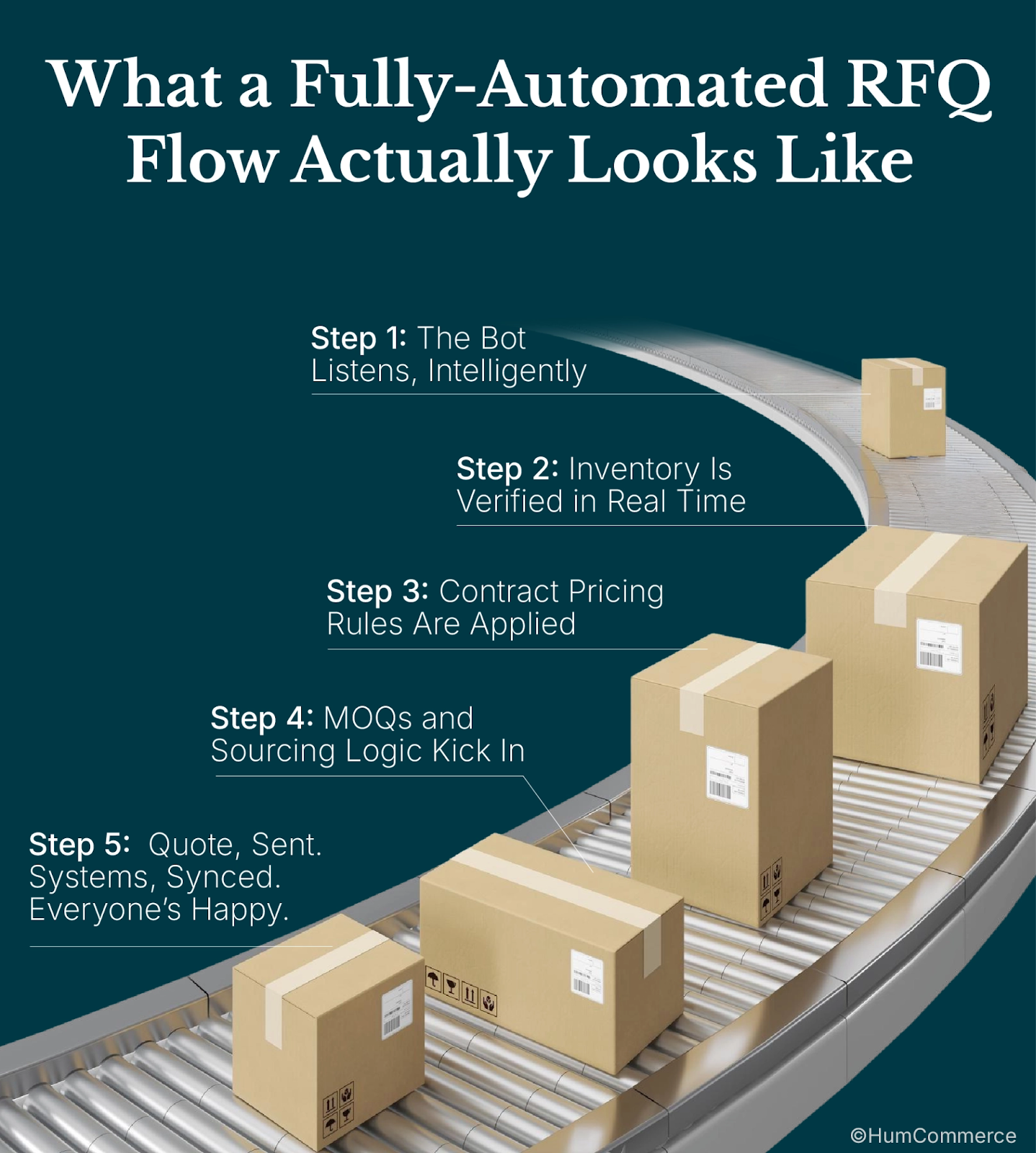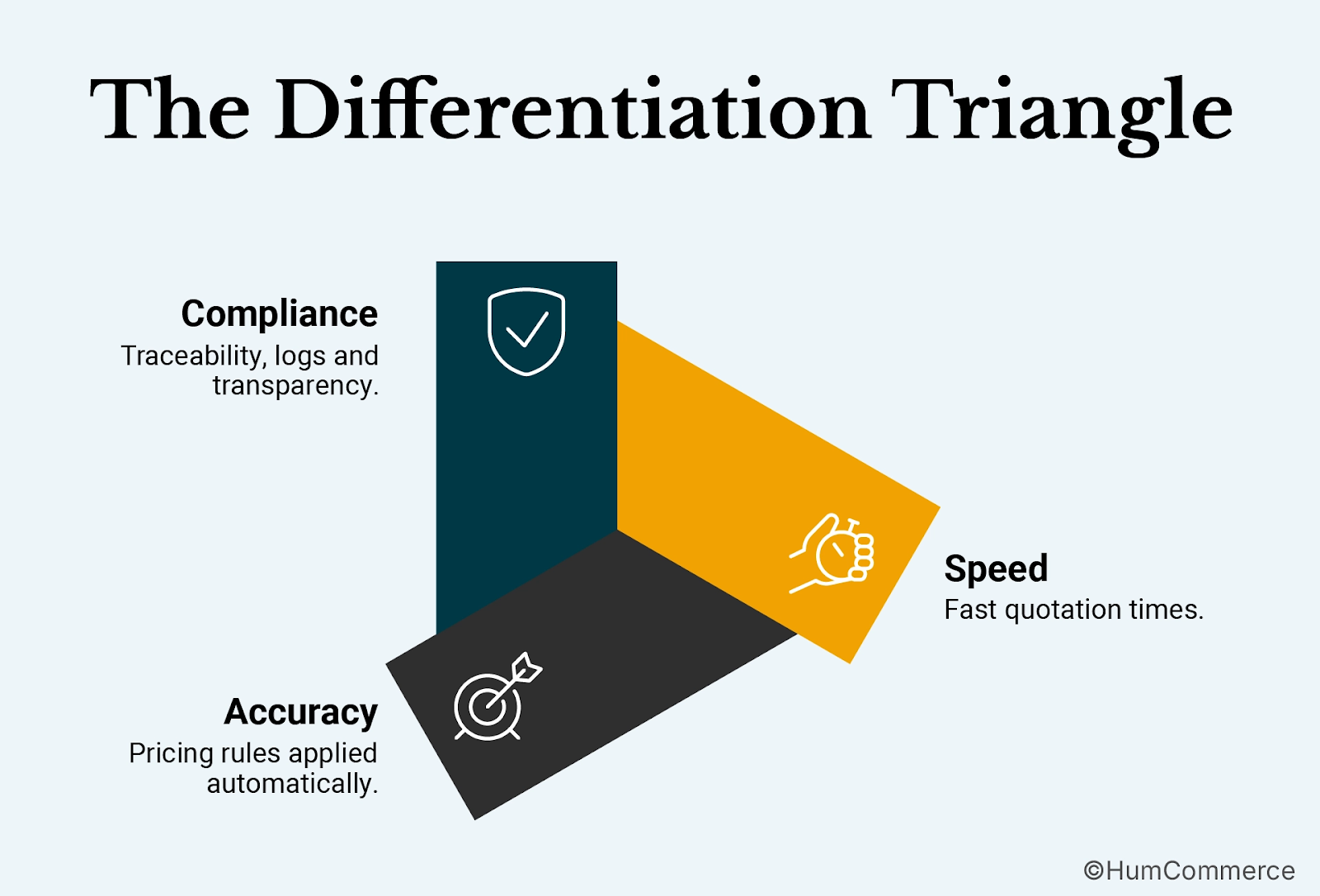Key Takeaways
- Manual RFQ workflows silently slow down industrial procurement
- AI chatbots accelerate bulk quoting by integrating with ERP and contract data
- NLP bots apply pricing rules, validate inventory, and auto-generate quotes at scale
- Businesses with 500+ SKUs and contract pricing see the biggest ROI from automation
- AI chatbots reduce errors, speed up response times, and free up sales teams
- Automation success depends on ERP access, SKU structure, and pricing governance
The clock starts ticking the moment the RFQ hits your inbox.
500 SKUs.
20 contract terms.
One impatient buyer.
Your ops lead pulls stock data from Magento.
Your finance team checks landed costs in SAP.
Your sales rep opens last year’s Excel file, hoping the pricing hasn’t changed.
And someone, somewhere, asks the dreaded question:
“Has anyone actually replied yet?”
This is how most B2B companies still handle bulk RFQs — manually stitching together systems that were never meant to talk to each other in real time.
But in 2025, RFQ delays aren’t just workflow problems. They’re missed deals, margin leaks, and broken buyer trust.
Because while you’re still validating SKUs…
Your competitor’s bot already quoted.
The 4-Minute Rule: Why RFQs Can’t Wait
It doesn’t matter how good your pricing is if the buyer never sees it.
In B2B, bulk RFQs used to buy you time. A day, maybe two.
Now? You get four minutes.
That’s the average time it takes for a modern B2B buyer used to real-time experiences in their personal lives to get distracted, frustrated, or worse, open your competitor’s tab.
And it’s not because they’re impatient. It’s because they’ve been retrained by Amazon, Shopify, and every D2C checkout they’ve ever touched.
Even in a B2B context, their brain expects:
- Live stock validation
- Accurate, contract-aligned pricing
- Instant feedback on quantity discounts or freight costs
Instead, here’s what happens in most bulk RFQ scenarios:
A buyer sends a request for 600 units across 40 SKUs.
The pricing team pulls historic quotes from shared folders.
Procurement checks availability in SAP.
Sales asks Ops to confirm regional delivery timelines.
Compliance verifies tax clauses and contract eligibility.
And by the time the quote is sent… it’s already outdated.
A study by Accenture found that 80% of frequent B2B buyers have switched suppliers at least once within a 24-month period due to suppliers not meeting their expectations, which includes responsiveness to inquiries and quotes.
This isn’t just lost speed. It’s lost intent.
RFQs aren’t top-of-funnel fluff. They’re late-stage, high-conversion moments.
Which means the cost of delay is pipeline erosion.
And the worst part?
Most of the delays aren’t even product-related.
They’re system-related.
- SAP doesn’t sync fast enough with Magento
- Contract pricing sits in a siloed database
- The bot can’t validate freight logic until Ops checks a spreadsheet
So yes, we call it the 4-Minute Rule, not as a gimmick, but as a psychological timer.
Why RFQs Still Break (Even When You Think They’re Automated)
You’ve added a chatbot to your B2B store.
It collects RFQ data, confirms the customer’s email, maybe even thanks them for their interest.
But that’s not automation. That’s a form with manners.
Real-time RFQs don’t break because of frontend experience. They break because of what happens after the form is submitted.
Let’s walk through what a bulk RFQ for 500+ SKUs looks like behind the curtain and where the chain snaps.
Step 1: Inventory Validation? Stuck in SAP
The NLP bot collects product data but it doesn’t validate availability.
Why? Because SAP is often batch-synced once a day.
So you could be promising availability that’s already gone.
Step 2: Pricing Logic? Locked in a Contract Folder
For contract customers, pricing isn’t on the product page.
It’s hidden in clause-heavy PDFs or Oracle billing rules.
The bot can’t apply those discounts unless there’s a pre-mapped rule engine in place.
Step 3: Approval Routing? Stuck in Email
Many quotes still go through email for human review.
Ops checks freight, Sales confirms MOQs, Finance approves margin.
The chatbot? Just waiting politely while people forward spreadsheets.
Step 4: Compliance Check? Optional Until It’s a Lawsuit
RFQs that cross borders or categories need tax, import, and doc validation.
But unless the bot talks to your compliance workflows, it can’t catch what’s non-compliant until it becomes non-billable.
And let’s not forget SKU mismatches.
When 40 line items get quoted manually, even a small misfire—a wrong unit of measure, a missed surcharge, an outdated HS code can void the quote entirely.
That’s not an RFQ. That’s a risk exposure.
What do the best setups do differently?
They don’t ask the bot to “collect and pass along.”
They embed the bot into a real-time validation workflow that speaks to:
- SAP (inventory + purchase data)
- Contract engine (pricing + customer terms)
- Freight logic (live rate inputs)
- Compliance rules (for region, product, and deal type)
Let’s talk about this in the next section.
What a Fully-Automated RFQ Flow Actually Looks Like
Let’s say a procurement head at a mid-sized hospital drops a bulk RFQ on your site—500+ SKUs, mostly repeat orders, some new. They expect a quote within minutes.
Here’s what happens when your systems are ready:

Step 1: The Bot Listens, Intelligently
Your NLP-powered chatbot parses the incoming RFQ in natural language—PDF, CSV, or typed directly into chat. It understands product groups, order intent, quantities, and delivery timelines. No need for structured forms or back-and-forth.
Step 2: Inventory Is Verified in Real Time
No need to hit refresh or wait for a team to verify stock manually. The bot instantly checks each SKU against live warehouse data across all zones. If something’s running low or already spoken for, it doesn’t just stop there. It flags lead times, suggests alternates, or shows when the next batch will be available pulling it straight from your Magento-integrated WMS.
Step 3: Contract Pricing Rules Are Applied
Pricing isn’t pulled from a flat file. The bot uses SAP SD pricing logic to apply buyer-specific terms including volume-based discounts, tariff-linked SKU rules, and bundled freight clauses — before the quote is finalized.
Step 4: MOQs and Sourcing Logic Kick In
If the order doesn’t meet your minimums, the bot doesn’t just reject it. It suggests ways to bundle items to hit MOQ or shows similar products that meet the buyer’s needs. Need to factor in landed costs, tariffs, or multiple suppliers? No problem. The bot pulls the latest data from your ERP, so the pricing stays accurate even when the rules change.
Step 5: Quote, Sent. Systems, Synced. Everyone’s Happy.
Once the bot has what it needs, it builds the quote—prices, timelines, terms, everything—and sends it out. No delays, no missing info. Magento logs the quote for your records. ERP syncs the whole exchange. Your team doesn’t need to chase spreadsheets, hop on a call, or re-enter anything manually. Just clear, fast quoting exactly how it should be.
At no point does a human chase data across systems. And that’s the difference between chatbot-as-a-service and an intelligent RFQ assistant built for industrial buying.
We break this down further in our eBook on tariff-ready B2B systems including real workflows and system maps.
Real-Time SAP Validation at Scale
Most delays in RFQ fulfillment start with SAP. Bots can’t quote accurately unless they’re connected to the right SAP modules.
At scale (500+ SKUs), this means integrating directly with SAP MM (Materials Management) for inventory visibility and SAP WM (Warehouse Management) to locate stock across plants. The bot queries live availability, lead times, and batch status using SAP APIs.
For distributed setups, we aggregate data across SAP instances and sync it to Magento in real time. This eliminates stale stock views and prevents over-promising inventory.
- Live stock checks via SAP MM + WM
- Real-time API sync across plants and warehouses
- Pre-hold SKUs during RFQ session to prevent double-quoting
Intelligent Contract Pricing Application
Contract pricing isn’t just about fixed discounts — it involves tiered rules, special clauses, and tariff-linked SKUs. Our RFQ system reads these conditions from SAP SD (Sales and Distribution) and applies them dynamically.
The NLP bot doesn’t just pull list prices. It checks customer-specific terms, MOQs, bundled discounts, and freight rules before quoting. This ensures that every RFQ is margin-protected and legally compliant, without human rework.
- SAP SD integration for pricing modules
- Real-time rule application for customer-specific terms
- Automated discount logic based on quantity or SKU bundles
What If Speed Becomes Your Differentiator?
You’ve fixed the quote lag. Now what?
Most brands stop here.
They patch the leak, maybe get RFQs down from 2 days to 2 hours, and move on. But what if that speed isn’t just operational hygiene? What if it’s the edge?
In industries like industrial supply, electrical, and HVAC, where specs change fast and quotes decide deals, response time is your bid quality.
Fast RFQs shift buyer perception. They make you the vendor who gets it, who can keep up, who makes their job easier.

Few competitors hit all three. Most pick one.
Fully automated RFQs — powered by NLP bots + SAP/Magento logic — let you offer all three at scale.
When your speed protects someone else’s margins, you earn a default position.
Why NLP Alone Won’t Save You
Chatbots are trending.
But a bot without structured systems behind it? That’s just… chat.
Most NLP-led RFQ bots fail not because the language model can’t parse the request but because the backend data is a mess.
You can’t quote what you can’t validate.
You can’t validate what your systems don’t sync.
Let’s break it down:
| Failure Point | What it looks like | What fixes it |
| SKU not recognized | “Item not found” or misquote | Unified PIM + NLP training loop |
| Contract pricing ignored | Bot gives generic pricing | SAP-Magento pricing logic integration |
| Inventory unavailable | Bot gives false positive | Real-time ERP sync w/ inventory rules |
| Tariff not applied | Margin hit or non-compliance | Dynamic landed cost pull from ERP |
NLP is the interface. Your ERP is the truth.
When those two don’t speak, you’re not automating RFQs, you’re automating confusion.
The solution isn’t just “add AI.” It’s built a contract-aware, SKU-aware, margin-protecting workflow and then let the AI talk.
Is This Setup Right for You?
Not every company needs a fully-automated RFQ engine.
But if any of the following sound familiar, you’re likely overdue:
- Your RFQ turnaround time is measured in days, not minutes.
(And Sales is manually chasing down pricing approvals every time.) - You manage 500+ SKUs across product lines and pricing fluctuates with tariffs, shipping, or volume.
- You have contract-based pricing rules that your store can’t enforce natively.
- Your ops team is stuck reconciling quotes with inventory in SAP, Magento, and spreadsheets.
- You’re juggling fulfillment across multiple warehouses or bonded zones and errors are quietly eating your margin.
If that’s your world, it’s not just about speeding up quote responses.
It’s about reclaiming the revenue that leaks out every time you respond too slowly, too manually, or too inconsistently.
Conclusion: The Quote Engine Is the Growth Engine
In high-volume B2B commerce, the quote isn’t just a formality. It’s the moment of truth.
It decides whether a buyer proceeds or walks away.
Whether your ops team handles scale or breaks under it. Whether your margin is protected or silently eroded by lag, mispricing, and rework.
What we’ve laid out isn’t just a technology upgrade.
It’s a shift in mindset from reacting to RFQs to orchestrating them.
When NLP bots validate inventory in real-time, apply contract pricing, and push orders seamlessly into Magento and SAP…
You don’t just move faster. You move with confidence.
And confidence is what closes bulk deals in volatile markets.
Want to see what a fully-automated, SAP-validated RFQ workflow looks like in action?
Download the full eBook or talk to the HumCommerce team for a quick readiness walkthrough.









